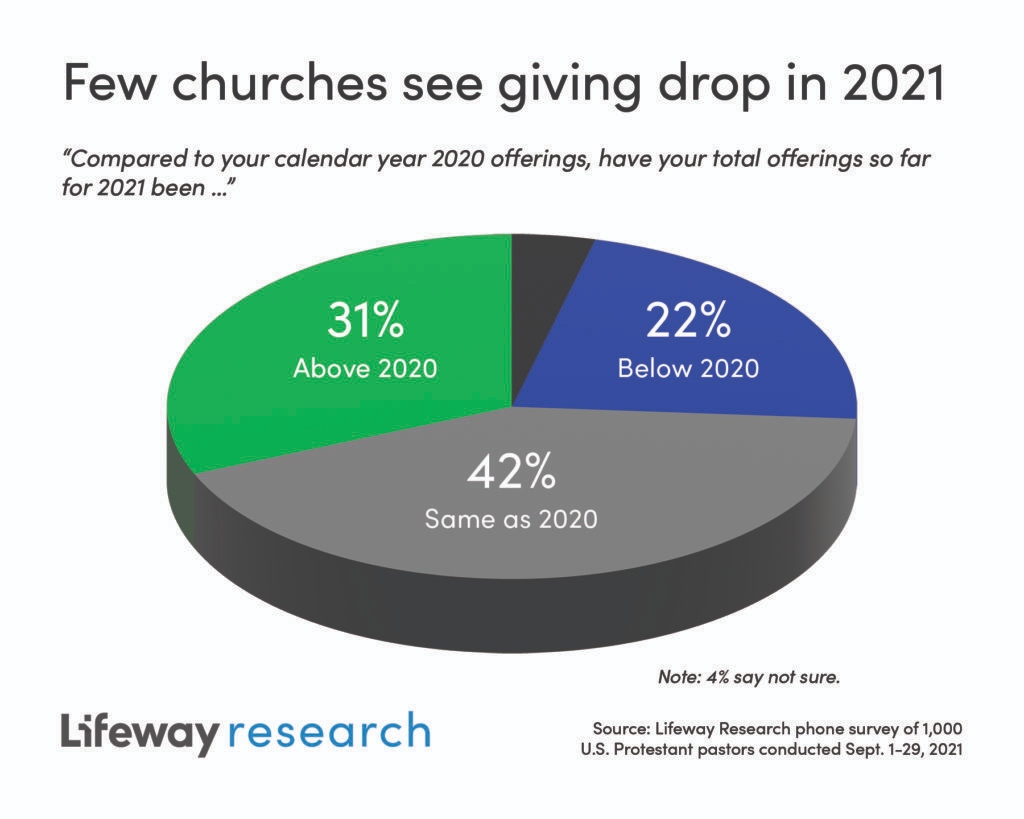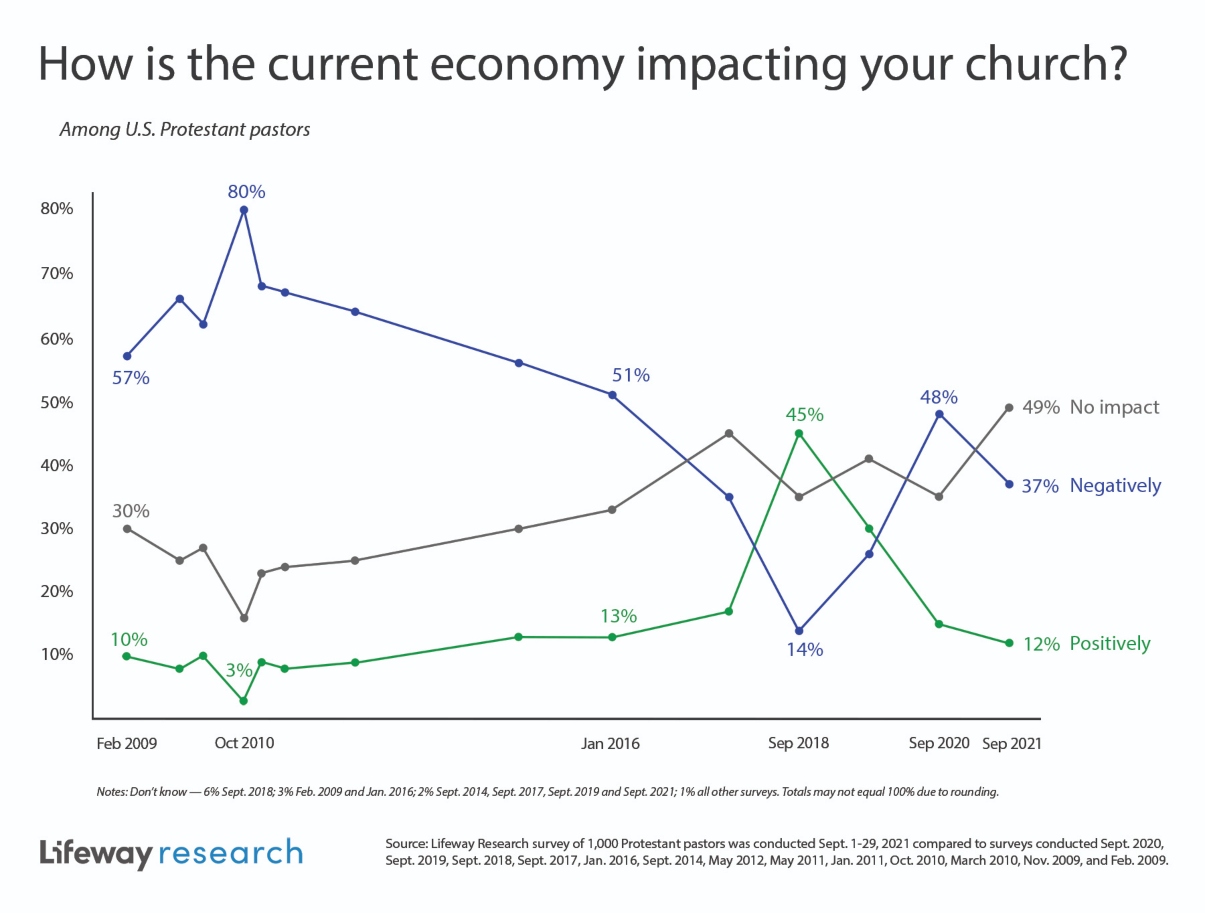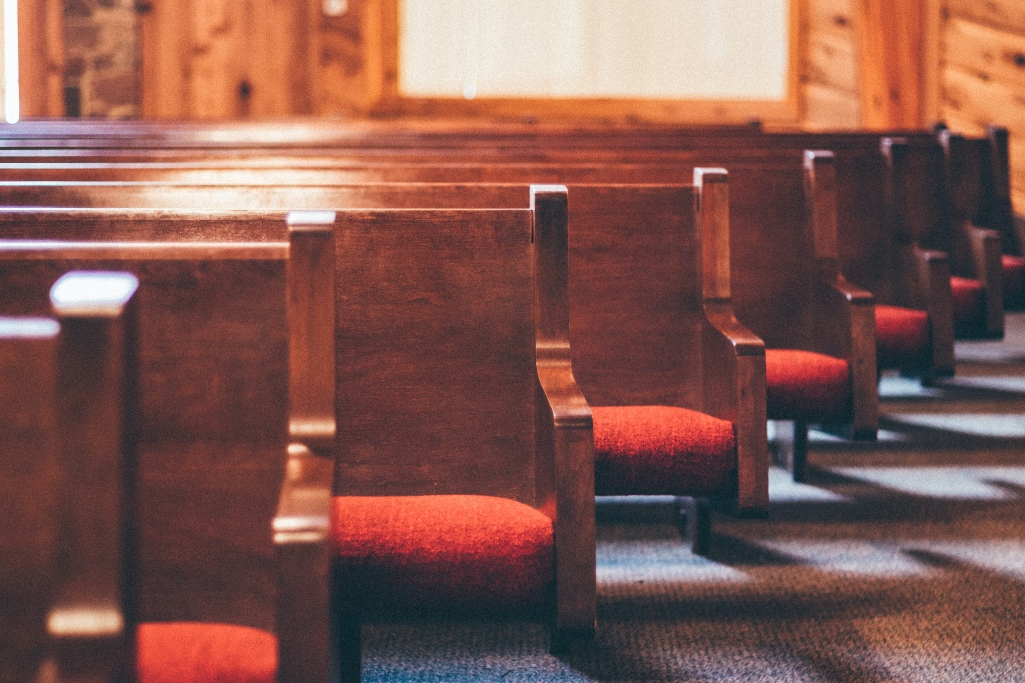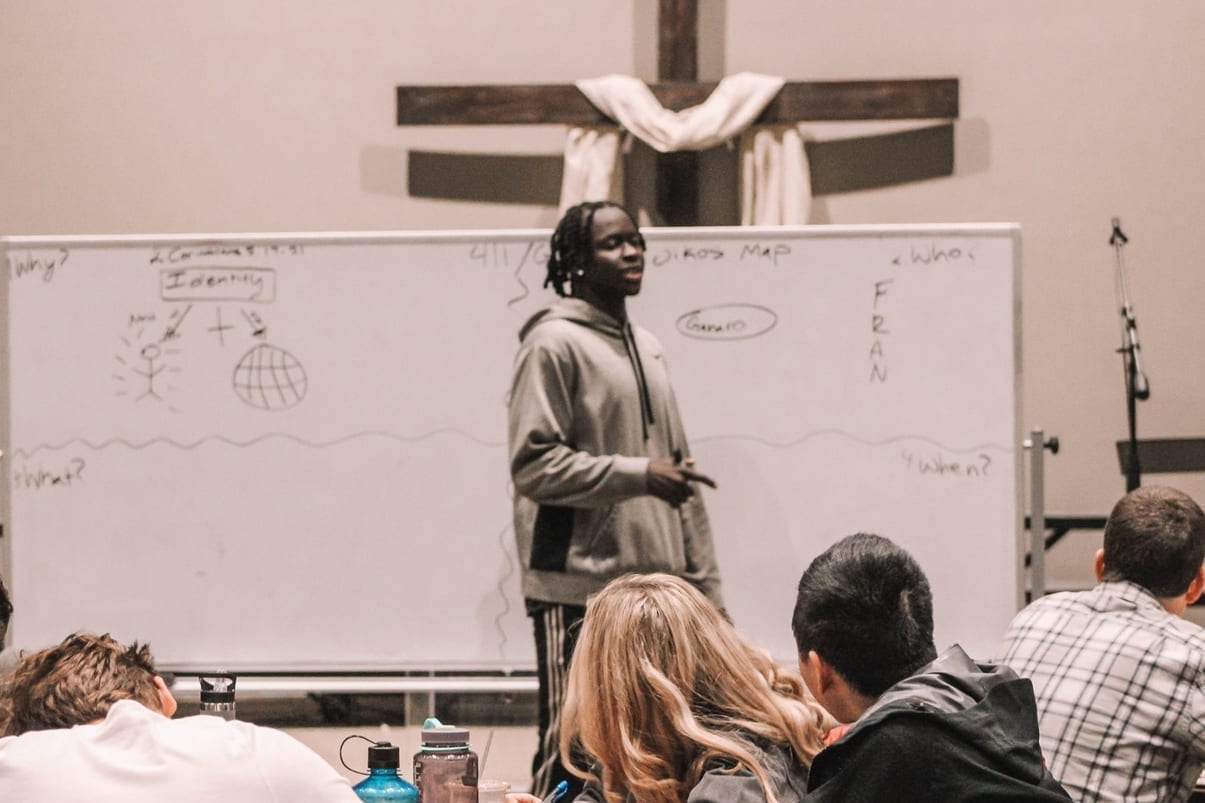Emerging from the pandemic, most churches don’t seem to be underwater financially, but many are treading water.
Around half of U.S. Protestant pastors say the current economy isn’t really having an impact on their congregation, according to a Lifeway Research study. The 49% who say the economy is having no impact on their church marks the highest percentage since Lifeway Research began surveying pastors on this issue in 2009.
Almost 2 in 5 pastors (37%) say the economy is negatively impacting their congregation, while 12% say the economy is having a positive impact. Both positive and negative numbers are down from September 2020, when 48% said the economy was hurting their congregation and 15% said it was helping. The last time fewer pastors than this year said the economy is playing a positive role for their church was May 2012.
The two years prior to the COVID-19 pandemic, 2018 and 2019, mark the only two times in the survey’s more than 12-year history that more pastors said the economy was having a positive impact than a negative one.
“Most churches are taking a deep breath financially following the uncertainty of the height of the pandemic,” said Scott McConnell, executive director of Lifeway Research. “While the official recession ended quickly in April 2020, economic growth has been uneven, and few churches are feeling actual positive impacts from the economy at this point.”
Giving rebound
After many churches faced budget shortfalls and decreased giving in 2020, 2021 saw most churches meet their budget and stop the decline in giving.
Seven in 10 pastors say offering levels at least met the budget this year. Almost half of churches (48%) say the giving at their church has been about what they budgeted, while 22% say it is higher than budgeted. Around a quarter of pastors (27%) say they didn’t make their budget with their giving levels.
Similarly, most churches say their 2021 offering so far matched or exceeded what they received during 2020. More than 2 in 5 pastors (42%) say it’s the same as last year. Three in 10 (31%) say the offering in 2021 is above 2020’s. Fewer than 1 in 4 (22%) say they’re behind last year’s giving levels.
“We see great improvement in the number of churches with a downward trend in giving,” McConnell said. “A year ago, more than a third of churches had seen giving decline, and 13 percentage points fewer say so today. Some of those churches may still be working to get back to 2019 levels, but the number with declining income is back around the historic norm.”

When asked about the specific percentage change from last year to this, 3 in 4 pastors (74%) say it is at or above 2020’s offering, including 47% who say it is the same; 9% who say it is up from 1% – 9%; 15% who say giving is up from 10% – 24%; and 3% who say the offering at their church has gone up by 25% or more.
Still, other pastors note a further decline in giving since 2020. For 3%, offerings dropped by less than 10%. Another 11% say it fell 10% – 24%. Around 1 in 14 churches (7%) say giving decreased by 25% or more since 2020.
“Churches where the financial news is bad, it tends to be really bad,” McConnell said. “Among churches with offerings below 2020, the declines are typically steep, double-digit declines in year-over-year giving. These churches are having to radically rethink their ministry.”
Trouble areas
While most pastors saw giving bounce back after 2020, others in some demographics continued to struggle with the economic fallout of the pandemic.

In recent years, African American pastors have been more likely to say the economy was having a negative impact on their congregation. In 2021, they were less likely than their white counterparts to say the economy was a neutral force for their church (39% to 51%).
African American pastors are also more likely than white pastors to say their giving in 2021 was lower than budgeted (43% to 25%). Specifically, they are 3.5 times more likely than white pastors to say their offering was down by 25% or more (21% to 6%).
Mainline Protestant churches are faring worse financially than evangelical ones. Mainline pastors are more likely than evangelical pastors to say their 2021 giving has been lower than budgeted (32% to 24%). Pastors at mainline churches are also more likely than those at evangelical congregations to say their giving is below 2020’s levels (26% to 20%).
“Mainline and African American churches were slower to resume in-person worship services amid the pandemic,” McConnell said. “This reduced face-to-face contact appears to have impacted giving in these churches.”
For more information, view the complete report or visit LifewayResearch.com.
Methodology
The phone survey of 1,000 Protestant pastors was conducted Sept. 1-29, 2021. The calling list was a stratified random sample, drawn from a list of all Protestant churches. Quotas were used for church size. Each interview was completed by the senior or sole pastor or a minister at the church. Responses were weighted by region and church size to more accurately reflect the population. The completed sample is 1,000 surveys. The sample provides 95% confidence that the sampling error does not exceed plus or minus 3.2%. This margin of error accounts for the effect of weighting. Margins of error are higher in sub-groups.
Comparisons are also made to the following telephone surveys using probability sampling:
- 1,002 pastors conducted Nov. 5-12, 2009
- 1,000 pastors conducted March 1-9, 2010
- 1,000 pastors conducted Oct. 7-14, 2010
- 1,002 pastors conducted Jan. 17-27, 2011
- 1,000 pastors conducted May 18-25, 2011
- 1,000 pastors conducted May 23-31, 2012
- 1,000 pastors conducted Sept. 11-18, 2014
- 1,000 pastors conducted Jan. 8-22, 2016
- 1,000 pastors conducted Aug. 29 – Sept. 11, 2018
- 1,000 pastors conducted Aug. 30 – Sept. 24, 2019
- 1,007 pastors conducted Sept. 2 – Oct. 2, 2020 (Mixed-mode telephone and online)
(EDITOR’S NOTE – Aaron Earls is a writer for LifeWay Christian Resources.)


